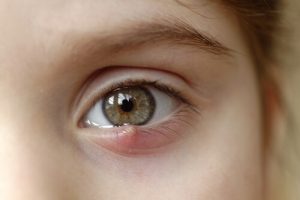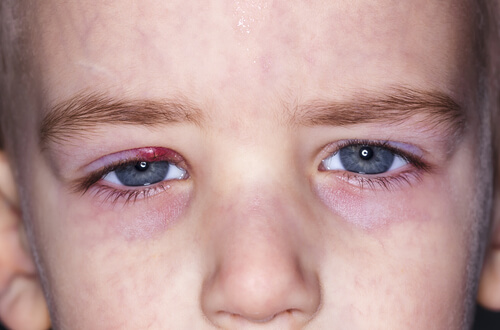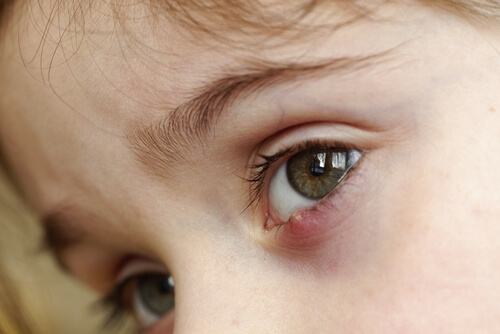Styes in Children: How to Treat Them

Because they sting and hurt, they’re usually one of the most hated conditions among adults and children alike. Here, we’ll review some tips on the treatment and prevention of styes in children.
Styes are nothing more than an inflammation of the skin, but surely styes have caused more than one headache for the children that suffer from them and for their mothers.
No matter how many times you say “don’t scratch,” children still do, which makes the situation worse. Anyway, anyone who has had a stye understands that compulsion perfectly.
What exactly is a stye? It’s a small inflammation filled with pus, located superficially on the root of the eyelashes.
The sebaceous glands (which produce sebum, or oil) or the sweat glands are what become inflamed. These glands are responsible for producing a liquid substance that lubricates the eyes.
A stye may appear on the upper or lower eyelid. It shouldn’t be confused with a chalazion, which appears in the same area but isn’t as painful and is often larger than a stye. The inflamed gland in these occasions is the Meibomian gland.
Styes can be external or internal. The latter, as the name suggests, occur below the skin and aren’t visible, but they’re just as painful. They take longer to heal, as the stye has less drainage capacity.
The symptoms of a stye are: redness and swelling of the eyelid, itching, painful to the touch, tearing in the eye and, finally, the appearance of a boil filled with pus.
The vast majority of styes disappear spontaneously.
Causes of styes in children
The cause of this disorder is a bacterial infection, usually by streptococcal and staphylococcal bacteria. The origin of a stye’s appearance doesn’t reside in any lack in the child’s immune system.
These are bacteria that live on our bodies and that, occasionally, can cause a blockage of sebum, dead skin cells or old skin bacteria.

How to treat styes in children
Besides the fact that the vast majority of styes disappear spontaneously, here are some recommendations to accelerate the healing process:
- Apply moist compresses to the inflamed area for 10 or 15 minutes, 3 to 4 times a day.
- To the previous option, you can also add an infusion of chamomile to calm the pain and help reduce the inflammation.
- If you go to the pediatrician, she can prescribe an ointment or eye drop to apply to the child’s eye.
- If the child wears contact lenses, they should be replaced by ordinary glasses until the infection disappears. When using lenses again, clean them with a suitable solution.
Normally, a stye takes 3 to 7 days to disappear. If it doesn’t go away, consult a doctor, as it may have become a cyst.
In that case, a small incision should be made to drain it. This is a painless solution performed under local anesthetic and doesn’t require suturing.
The origin of the appearance of a stye doesn’t reside in any deficiency in the child’s immune system.
What NOT to do to treat a stye
Perhaps even more important than what should be done to treat a stye is what should not be done. These are the 3 resounding no’s to consider:
- Don’t squeeze them. If you try to burst it, you could cause a bigger infection.
- Don’t rub it. Make sure your child doesn’t scratch the inflamed area. It will only aggravate the infection.
- Don’t apply creams or products without a medical recommendation. Its proximity to the eye makes it a sensitive area, and the use of uncontrolled products can cause major damage.

How to prevent styes in children
The most effective way to prevent styes in children is to maintain good daily hygiene.
The child should wash his hands well and, if he has already had styes previously, it’s a good idea to occasionally clean the sebum that accumulates on the eyelids.
Likewise, it’s vitally important to sanitize one’s hands before handling contact lenses, as they directly contact the eye when placing them in.
For adults, it’s also advisable to remove all makeup before going to sleep, as well as periodically checking the condition of mascara, eyeliner and eye shadow, especially if they haven’t been used for a long period of time.
In addition, it must be taken into account that those who have a stye shouldn’t share personal items with other people, such as towels, pillows or sunglasses, among other examples.
All cited sources were thoroughly reviewed by our team to ensure their quality, reliability, currency, and validity. The bibliography of this article was considered reliable and of academic or scientific accuracy.
- AskMayoExpert. Hordeolum (stye). Rochester, Minn: Mayo Foundation for Medical Education and Research; 2014.
- Lindsley K, Nichols JJ, Dickersin K. Non-surgical interventions for acute internal hordeolum. Cochrane Database of Syst Rev. 2017;1:CD007742
This text is provided for informational purposes only and does not replace consultation with a professional. If in doubt, consult your specialist.
